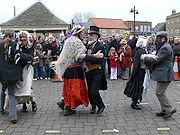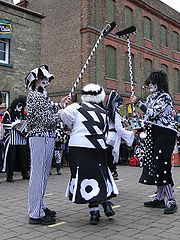
Molly dance
Encyclopedia

Morris dance
Morris dance is a form of English folk dance usually accompanied by music. It is based on rhythmic stepping and the execution of choreographed figures by a group of dancers. Implements such as sticks, swords, handkerchiefs and bells may also be wielded by the dancers...
, traditionally done by out of work ploughboys in midwinter in the 19th century.
History
Molly dancing has been recorded in many parts of the English MidlandsEnglish Midlands
The Midlands, or the English Midlands, is the traditional name for the area comprising central England that broadly corresponds to the early medieval Kingdom of Mercia. It borders Southern England, Northern England, East Anglia and Wales. Its largest city is Birmingham, and it was an important...
and East Anglia
East Anglia
East Anglia is a traditional name for a region of eastern England, named after an ancient Anglo-Saxon kingdom, the Kingdom of the East Angles. The Angles took their name from their homeland Angeln, in northern Germany. East Anglia initially consisted of Norfolk and Suffolk, but upon the marriage of...
. It died out finally in the 1930s, the last dancers seen dancing in Little Downham near Ely, Cambridgeshire
Ely, Cambridgeshire
Ely is a cathedral city in Cambridgeshire, England, 14 miles north-northeast of Cambridge and about by road from London. It is built on a Lower Greensand island, which at a maximum elevation of is the highest land in the Fens...
in 1933. On this occasion the dances performed included a tango, performed by two male dancers, one dressed as a woman.
The only recorded Molly dances come from Comberton and Girton, villages just outside Cambridge
Cambridge
The city of Cambridge is a university town and the administrative centre of the county of Cambridgeshire, England. It lies in East Anglia about north of London. Cambridge is at the heart of the high-technology centre known as Silicon Fen – a play on Silicon Valley and the fens surrounding the...
, researched by Russell Wortley and Cyril Papworth. Some examples of the music played for the dancers have survived. These include George Green's College Hornpipe, collected from the Little Downham Melodeon player.
'Molly dancing' also occurred throughout north Manchester and Salford on and around May Day (last recorded incidence in Salford c1963). Though (at least by this date) there was no dancing as such, just children dressing up (the boys dressed as girls, and wearing rouge), who would then journey from house to house asking for small amounts of cash. This tradtion was recorded in the works of 'the Opies', who wrote of journeying across Manchester one May Day in the 1950s and seeing many children taking part in this, and the related traditon (for girls) of May Queen celebrations. 'Molly dancing' in Manchester was subject of a BBC Radio 4 'Making History' programme, and elicted a wide response from readers who remembered taking part. The tradition died out rapidly in the late 1950s, in large part because of post-war 'slum clearance' programmes, which resulted in the widespread demolition of housing, and the break-up of communities throughout Manchester
Traditions
Molly dancing is most associated with Plough MondayPlough Monday
Plough Monday is the traditional start of the English agricultural year. While local practices may vary, Plough Monday is generally the first Monday after Twelfth Day , 6 January. References to Plough Monday date back to the late 15th century...
, the first Monday after Epiphany
Epiphany (Christian)
Epiphany, or Theophany, meaning "vision of God",...
. Tradition has it that as a way of filling the gap between Christmas and the start of the Spring ploughing season, the ploughboys would tour around the village landowners, offering to dance for money. Those who refused would be penalised in various ways (see Trick or treat
Trick or Treat
Trick or Treat is a 1952 American animated short film produced by Walt Disney Productions and released by RKO Radio Pictures. The cartoon, which takes place on Halloween night, follows a series of pranks between Donald Duck and his nephews Huey, Dewey, and Louie who are aided by Witch Hazel...
) including having a furrow ploughed across the offender's lawn.
The dancers, wishing to gain employment from those same landowners shortly afterwards, would attempt to conceal their identities by blacking their faces with soot and dressing up in a modified version of their Sunday Best
Sunday Best
Sunday best or Sunday Best can mean:* Sunday best clothes, traditionally reserved for wearing to church on Sundays* Sunday Best * Sunday Best...
, typically black garments adorned with coloured scarves and other fripperies. It was originally an all-male tradition but with one of the members - the Molly - dressed up as a woman.

The modern tradition
Molly dancing was revived by the Cambridge Morris Men in 1977 to coincide with the revival of the Balsham Ploughboys. The Cambridge Men still dance Molly during the day on Plough Monday. The Morris danceMorris dance
Morris dance is a form of English folk dance usually accompanied by music. It is based on rhythmic stepping and the execution of choreographed figures by a group of dancers. Implements such as sticks, swords, handkerchiefs and bells may also be wielded by the dancers...
revival of the 1970s led to the creation of many new sides, which nowadays usually involve both men and women.
In recent years, Molly Dancing has enjoyed a popular revival both in East Anglia and further afield; one of the best-known teams being the Ouse Washes Molly Dancers. The largest regular assemblage of Molly Dancers is at the Whittlesea Straw Bear Festival, established 1980, which is held in Whittlesey
Whittlesey
Whittlesey, historically known as Whittlesea as the name of the railway station is still spelt, or Witesie, is an ancient Fenland market town around six miles east of Peterborough in the county of Cambridgeshire in England...
, Cambridgeshire, every January.
Modern Molly Dancing demonstrates the clearest distinction between "re-enactment of tradition" and "modern interpretation of tradition" of modern morris dancing. Elaine Bradtke wrote a PhD thesis on the inherent post-modernism of the Seven Champions - one of the first and best examples of Modern Molly dance. Many other teams have developed Molly, inspired by the unhistorical but very effective military formations of Seven Champions (e.g. Ouse Washes, Gog Magog, Handsome Molly in New Jersey) whilst others have taken it in new directions - equally unhistorical but at their best equally effective in very different ways - e.g. Norwich Shitwitches (now renamed Kit Witches), Pig Dyke Molly.
To this day Deptford Fowlers' Troop perform molly dances, as well as parading Jack in the Green
Jack in the green
A Jack in the Green is a participant in traditional English May Day parades and other May celebrations, who wears a large, foliage-covered, garland-like framework, usually pyramidal or conical in shape, which covers his body from head to foot...
. They take their name from a century-old Troop depicted in a photograph of 1906.
Teams
- Seven Champions Molly Dancers
- Ouse Washes Molly Dancers
- Gog Magog Molly
- Handsome Molly
- Norwich Shitwitches
- Pig Dyke Molly
- Black Dog Molly
- Old Glory
- Soken Molly Gang
- Green River Tap & Die
Good Easter Molly Gang,
Mepal Molly,
Midlands Molly

